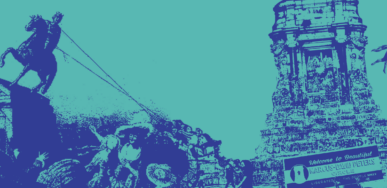
Season 3, Episode 9
No Country is a Shangri-La
Martien Halvorson-Taylor I'm Martien Halvorson-Taylor.
Kurtis Schaeffer And I'm Kurtis Schaeffer
Martien Halvorson-Taylor And this is Sacred & Profane. Every year in Bhutan's Pobjihka Valley, locals climb the hill to Gangteng Monastery. And they're not the only ones. School kids in costumes are joined by Bhutanese from other valleys, Buddhist clergy and tourists from all over the world. Even Bhutan's royal family are all there to welcome another very special group of travelers, the endangered black necked crane.
Kurtis Schaeffer The cranes fly in from Tibet where they summer in the high Himalayas to spend their winters in this more hospitable valley in Bhutan. The Pobjihka Valley has been welcoming them for many, many years, for so long, in fact, that the cranes seem to use the monastery itself as a landmark on their journey. Each year, they circle above this massive Buddhist complex several times before they glide down into the valley, landing among farms and wetlands.
Martien Halvorson-Taylor The cranes are one of the many attractions that draw hundreds of thousands of tourists to Bhutan annually. Despite the high cost of the country's tourist visa, which is $200 per day. Bhutan shares a border with the Tibetan autonomous region of China. And like its northern neighbor, Bhutan is often painted as a kind of Shangri-La.
Film Clip In the towering Himalayas between South Asia and China. A legendary kingdom of peace and tranquility.
Martien Halvorson-Taylor Tourists are often looking for a paradise. It's a deeply religious country where people live in balance with nature untouched by the problems of more worldly industrialized nations.
Film Clip A land that is rich not in gold or earthly wealth. But in the soul of its people.
Film Clip Where ritual and prayer mark all aspects of daily life.
Kurtis Schaeffer But of course, no country is Shangri-La. And that's why we went to Bhutan: to experience firsthand how a country with lofty Buddhist ideals and a global reputation to match responds to global and local challenges. We traveled with a group of colleagues from many scholarly disciplines. You'll hear from some of them in this episode. Our group was exploring how climate change is affecting religious sites all over the world and how people adapt these often ancient sites to meet new challenges. Bhutan is one of many countries actively working to flourish in a changing world, and the only one whose democratically elected government is so thoroughly integrated with Buddhist tradition and ways of life. But as you'll hear, even with the best of intentions, development is complicated. Bhutan's new East-West Highway brings more tourists to see the cranes in Pobjihka. But it also brings cheap goods that can undercut the local farmers there and plastics that end up in the very wetlands Bhutan is trying to protect.
Tshering Tobgay We've been called Shangri-La. Even the last Shangri-La. But let me tell you right off the bat, we are not Shangri-La. My country is not one big monastery populated with happy monks. The reality is that they are barely 700,000 of us, sandwiched between two of the most populated countries on Earth, China and India.
Kurtis Schaeffer That's the former prime minister of Bhutan Tshering Tobgay, speaking in a TED talk.
Tshering Tobgay The reality is that we are a small, underdeveloped country doing our best to survive. But we are doing okay. We are surviving. In fact, we are thriving. Balancing economic growth carefully with social development, environmental sustainability and cultural preservation all within the framework of good governance. We call this holistic approach to development. Gross national happiness.
Martien Halvorson-Taylor Gross National happiness is meant to serve as an alternative to the way that many countries measure their development. Using gross domestic product, which prioritizes constant economic growth and gross National happiness is just one way that Bhutan is unusual. Bhutan is one of only a handful of countries in the world that can claim to be carbon negative. That is to say, Bhutan's forests draw down more carbon than Bhutanese people emit. And part of that is due to a unique clause in their Constitution.
Sonam Choden So, I'm Sonam Choden. I work with the government. I work with the Department of Forests and Bus Services to be specific and to be more specific work. I will critique watching wetlands programs. I have strong advocate for wetland conservation.
Kurtis Schaeffer Sonam has always been interested in the natural world. She told us her nickname is Lem-lem. t's hard to translate, but it roughly means wet. It comes from her childhood love of nature, water in particular.
Sonam Choden I come from Wangdi. It's arid area, a litle drier area. When the first monsoon rain hits Wangdi. The heart beats on it's a hot place and in the summer months, then you can smell it. I can describe the smell, but it's a feeling. And then you see the plants sprout. That's there was all this my like a positive thing.
Martien Halvorson-Taylor She says that Bhutan's mandate to conserve its forests has had a profound effect on the country. Bhutan's forests cover plenty of villages, temples and farms. They're used by hunters, foragers, farmers and loggers.
Sonam Choden All Bhutanese is a trustee of the environment, which doesn't mean that we'll need the government as the trustee of the environment. It's all citizens of Bhutan so that the part of the government you're not part of the government or you're a businessman or your farmer and you you are a trustee of the environment. That in itself is very significant.
Martien Halvorson-Taylor Sonam also thinks religion does play a part in the protections Bhutan has built into the Constitution.
Sonam Choden I would say so because the Bhutanese, the Buddhist Buddhist philosophy I have to say it's a way of living, right? So there's a lot of respect for nature, there's a lot of reverence for spirits.
Kurtis Schaeffer Traveling throughout Bhutan. It's hard to miss the shrines that dot the landscape. Some are dedicated to what we might call nature spirits figures that pre-date the arrival of Buddhism in Bhutan. Many people believe that in order to build a house, for example, you would need to consult with local spirits to make sure that the building is not interfering with their habitat. And that belief is not in conflict with Buddhist teachings. To do no harm is a cornerstone of Buddhist ethics.
Sonam Choden You know, these are the basic philosophies. Well, we've always been taught that the land is not owned by us or you cannot own land. It has to be gifted somehow. So we always lived with nature. I'm sure you've been you've traveled. You might have seen the shrines. Look, there are big trees next to the temples and all the I think there's a lot of reverence for nature and that there is a certain kind of spirit there. And there's something, you know, something that you cannot see with your eyes.
Martien Halvorson-Taylor And that's what we saw playing out in the Pobjihka Valley with the famous black necked cranes. Secular and religious ideas about conservation and protection of nature, often working hand in hand. When we went to the Gongteng Monastery in December 2019, the cranes had already settled in for the winter in the valley below and most of the tourists had gone home. The monastery was taking advantage of the off season to do some much needed restorations.
Kurtis Schaeffer But even at a distance, black necked cranes are hard to miss with an eight foot wingspan and striking black patches on pure white wings and necks. These black neck cranes are just some of several thousand still left in the wild. Their habitat and migration are under threat as wetlands are drained and power lines go up.
Martien Halvorson-Taylor Down in the valley, we were able to see a complicated dance as Publica navigates the needs of local farmers, Buddhist monasteries, tourists, and of course, the cranes themselves. These aren't just questions that affect Pobjihka. The whole country has been wrestling with how to balance cultural preservation, growth and the environment for decades.
Kurtis Schaeffer So we're in the Pobjihka Valley, which is famous because it's a sanctuary for black neck cranes, But cranes come here for the winter. They come from Tibet, where they were for the summer. And a major tourism industry has. Developed in the valley. And because of that. The Cranes sanctuary. So it's quite a wealthy valley here. This is our first day here.
Tsering But especially in Bhutan, they started considering it as an important only from 1997. Yeah. And then until that time, people never realized or people never recognize as the indigenous species are so important. Only from 1998 and before that, just to grazing land and nothing Winter. Yeah. Yeah.
Martien Halvorson-Taylor That's our guide Tsering. He showed us how the cranes don't just stay in the wetlands near the river. They also venture up the valley's slopes into farmer's fields.
Karen McClathery But they like farming.
Tsering They do like about of was in winter, since they don't grow much of crops. So that farming also they sometimes even use as a ruse to once they finish with the harvesting of the names and whatever they are growing in the field now. So maybe another two weeks. So they will finish with the harvest and they really feel and they just have waited for other next year in summer season. So until that time they even come sometime in the morning day full of greens will come here and they will eat, they feed on those leftover see Tyson foods like potatoes.
Karen McClathery So this is the perfect place because you have both farming and then you have the wetland.
Tsering Yes. For the kids and you have birds. And now this farming season adjusted to the migratory. Yes, it is. Especially this valley has been really put it to just protect it from them and for them, you know and number it has been also increasing like has.
Kurtis Schaeffer The government has worked hard to make sure that other protections for the cranes also benefit or at least don't hurt local farmers. For example, the government invested in burying power lines in the valley. That means cranes won't fly into live electrical wires, and it also means more reliable power in the valley after bad weather.
Martien Halvorson-Taylor A win win?
Kurtis Schaeffer Absolutely.
Kurtis Schaeffer More controversially, farmers in the valley are not supposed to regularly use chemical pesticides, which can accumulate in the water and harm cranes and other wildlife. But Bhutan shares a long border with India, where farmers can use pesticides, which makes their crops much cheaper.
Tsering But ever since Bhutan is opened to India, we started saying we import a lot of vegetables, including from India. And quite recently, in a crisis three years back, government found that they have been using too much of pesticide in especially cauliflower and chili in chili. So but the news cannot live without chili, especially in winter. So government have banned importing of chili and cauliflower some other vegetables.
Kurtis Schaeffer The idea is to give local farmers using more labor intensive methods a chance to compete.
Tsering But people are still importing illegally. They never realize why government... And so some people even end up being like huge amount. So if anyone found bringing chili so they fine, like 166. And at that time, they have to pay the fine.
Martien Halvorson-Taylor As we've said before, no place is a Shangri-La. Even in a place where many are committed to protecting the environment, people gravitate toward convenience. As much as the Bhutanese government tries to promote slow development and to protect traditional material culture, local makers often compete with cheaper imports of food and clothing from India.
Kurtis Schaeffer I have to say, I've been to Bhutan before and that was something I noticed right away on this trip. You see imported snacks and drinks everywhere, and that means there is also a lot more plastic waste, especially in the waterways. It was so striking to me. I asked some Bhutanese colleagues who hadn't joined us for part of the trip if they had noticed it. Sonam Neyenda said that had been a huge change as Bhutan opened up over the last decades.
Sonam Neyenda I remember my dad telling me about the first introduction to Plastic Products, and my dad used to say that we have experts in producing our only goods like utensils at home, like buckets, wooden buckets and buckets made from bamboos. And then people who make this products would like bring it to the other dzongs, or the other districts to to exchange with food, for example, like red rice and dried chilies. And then later when they went to the the bordering towns. So when they went there, they found the plastic buckets and then like, because that excited their thoughts, it's lightener and easier to carry. And then after that, like modernization started, and then the modernization in Bhutan, it started like very fast. My assumption is that we didn't get a good time to the process. I was thinking about the plastic and the challenges that we would face, and then suddenly there's like huge, like plastic products like those like plastic plate mugs and then like plastic like chips and then all those food items that is packed in a plastic.
Martien Halvorson-Taylor We also spoke with other people who observed that development has come at a cost. On our way out to Pobjihka, we stopped for the night at the home of Aji Kunzang Choden. She grew up in rural Bhutan and says that she's also seen a change since the government put in a new East-West road, a major engineering achievement that meant cutting across and sometimes through Bhutan's steep mountains.
Kunzang Choden We've been told by Lamas not to make big structures and to destroy the environment. That's how Longchempa wanted it and leave it that way, that the way it is, and not to make a road, not to build anything like this. So that's what that's what's keeping it. But I think they will soon meet some people and if they get some Chinese money, don't things like this are happening? That's happening and I don't know for how long it'll be. Just left the forest.
Martien Halvorson-Taylor In the last few years, trees have been cut down and stones taken from around an important local site associated with a famous Buddhist poet, Longchempa.
Kunzang Choden We are a stone starved area because a government's protection of the environment is so strong that, you know, we live in the forest, but it's very difficult to get wood, it's very difficult to get stones. So when people start rebuilding and burying their homes, they just took it out of necessity. And I think the older people talk about it with regret, but the people who took it and used it were not. They are happy that they had some stones. Yeah. So it all disappeared. This and you know it does necessity no other reason and I with what. Whether they feel blessed use any good or whether they felt guilty about desecrating the sacred place, I don't know.
Kurtis Schaeffer All of this to say conservation is complicated. It takes constant work. There was a moment on our trip that seemed to sum up what the government was trying to do to harness tradition, religion and the outside money that development could bring.
Martien Halvorson-Taylor Our group visited a much smaller temple down in the Pobjihka Valley, one that doesn't get nearly the attention that the Gong Tang Temple does with its annual crane festival. This temple is surrounded by farmland. So as the caretaker monks explain the temple's religious art, their neighbor was using a chainsaw to cut new fence posts just outside. And the sound echoed through the valley.
Kurtis Schaeffer Our colleague Ariana Maki noticed something unusual in the freshly restored frescoes normally and Buddhist art. You might see peacocks repeated as a motif around bodhisattvas or Buddhist saints, but not in this temple.
Ariana Maki The murals over there. If you look directly to the left of the main figure, there are two tone tone in the mural that.
Martien Halvorson-Taylor The bird she's pointing out are in fact black necked cranes.
Ariana Maki Which is is interesting because often we will see maybe peacock or or white cranes or something, But here it's the tom tom. You know, it's nice to see.
Martien Halvorson-Taylor Our guide translated the caretaker Monk's explanation.
Tsering: So he like is narrating main source of the upgrading the temple is the crane, and because of the black neck crane, many of the foreigners, they are coming. And on top of that, some are the followers of the Longchempa. So they are visiting here, looking at the story and because of that you get little donations. And with the help of cranes this happened, but because of the cranes they are getting help to upgrade the temples for the donations.
Kurtis Schaeffer Only time will tell if all these efforts are successful, if the cranes can thrive and if the Bhutanese can keep thriving along with them. As global heating continues. If communities like Pobjihka can continue balancing the many forces at play so that tourism, wildlife and tradition are not in competition, but in that moment it seemed to possible.
Martien Halvorson-Taylor This is the final episode of our third season of Sacred and Profane. We'll be back soon with a whole new one that will explore how religion shapes how we think about and respond to climate change here in the U.S.. Stay tuned.
Kurtis Schaeffer Sacred & Profane was produced for the Religion, Race and Democracy Lab at the University of Virginia. Our senior producer is Emily Gadek. Special thanks to our colleagues Ariana Maki, Matthew Bertner, John Cannon, Willis Jenkins, Karen McClathery, Erika Share and Devon Zuckerman.
Martien Halvorson-Taylor Music for this episode comes from Blue Dot Sessions. You can find out more about our work at Religion Lab dot Virginia Dot Edu, or by following us on Twitter at the Religion Lab.
Bhutan is a small country in the Himalayas with a long Buddhist tradition, and a more recent reputation for embracing careful development and cultural preservation. Many of the visitors who are willing to pay the $200 a day tourist visa to come to Bhutan are drawn to a beautiful landscape that’s seen as largely untouched by the problems facing more industrialized nations.
But of course, no country is Shangri-La. We traveled with a group of colleagues from many scholarly disciplines, part of a larger project exploring how climate change is affecting religious sites all over the world, and how people are working to adapt these often ancient sites. Bhutan is one of many countries actively working to flourish in a changing world, and the only one whose democratically-elected government is so thoroughly integrated with Buddhist institutions and ways of life. But, as you’ll hear, even with the best of intentions, development is complicated. We spoke with people across Bhutan about the real choices and challenges that come with efforts to balance tradition, development, and environmental preservation. And we look at one valley in particular that is trying to balance the needs of local farmers, international tourism, and the endangered black-necked crane.
Additional Reading
Choden, Kunzang. Tales in Color and Other Stories. Zubaan Books, 2009.
Thinley, Lopen Kunzang. Seeds of Faith: A Comprehensive Guide to the Sacred Places of Bhutan Vol. 3. Edited by Ariana Maki. KMT Press, Thimpu. 2016.
Phuntsho, Karma. The History of Bhutan. University of Chicago Press, 2013.
Additional Credits
You heard the voices of Sonam Choden, Aji Kunzang Chuden, Sonam Neyenda, Tshering, and Ariana Maki.
Special thanks to our colleagues Ariana Maki, Matthew Burtner, Jon Cannon, Willis Jenkins, Karen McClathery, Erika Share, and Devin Zuckerman.





